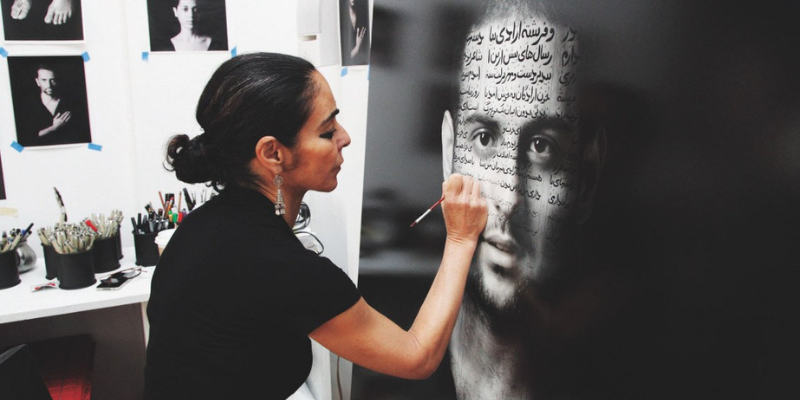Persian or Iranian art is one of the world’s greatest art heritages, dating back more than 2,500 years. Despite Iran’s complicated political background, spanning decades of political turbulence and societal upheaval, has not hindered artistic progress in this Middle Eastern country. The impact of these socio-political transformations in Iran is not only seen in its diverse population but also in its arts and cultural practices. This changing context has acted as a catalyst for artists to rebel and express themselves through their visual imagery, especially women artists. The Islamic law in Iran imposes severe social, cultural, and financial restrictions on Iranian women. Consequently, female artists have utilised their art to convey their inner emotions and responses to the world around them.
Iranian women were instrumental in bringing about radical change, urging for their rights, and resisting discrimination. Their power extends to Iran’s cultural, sociopolitical, and economic dimensions. Through their powerful and thought-provoking art, contemporary women artists in Iran recorded various themes from daily life in Iran, representing topics such as the beauty and delicacy of Iranian culture, as well as the resilience and strength of women. This article examines a few of the many Iranian women artists working in a variety of mediums who have been persistent in expressing themselves through visual language and have made significant contributions to the art scene of Iran by representing the country on a global front.
Lyrical abstraction in Pariyoush Ganji’s art.
Pariyoush Ganji, a Tabriz-based Iranian painter and art instructor, has a unique style rooted in Sumi-e to Fauvism.
“I can only depict the faces of those with whom I have some kind of inner dialogue.” (Ganji, 2022)
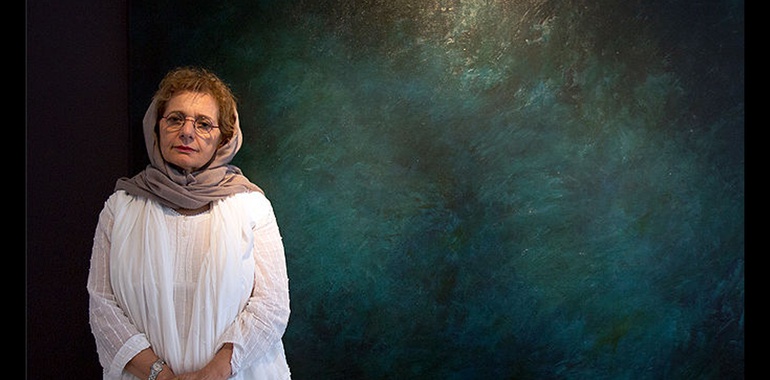 Pariyoush Ganji, https://www.artymag.ir/
Pariyoush Ganji, https://www.artymag.ir/
Her father was a textile designer and printer. Ganji began learning painting and miniatures at the “Behzad” Girls Fine Arts Conservatory and studied fabric design and printing processes. After completing her training in Iran, she travelled to England and completed her textile design studies at the Hammersmith College of Arts in London. She worked in Germany before enrolling in a free course at the School of Fine Arts in Paris, where she gained fresh ideas and techniques from European expressionist artists and colour experiments. After returning to Iran, she briefly worked at the Centre for Intellectual Development of Children and Adolescents and taught textile design and printing at Iran University of Arts and Al-Zahra University. Ganji is the first Iranian artist to be awarded the UNESCO Comparative Art Research Scholarship and has studied Iranian themes on Japanese kimonos, particularly those from the Sassanid period.
Ganji’s “Water” series is a notable body of work that combines expressionism with lyrical abstraction. Her works use figurative brushstrokes that evoke leaves, waves, and particles. These brushstrokes’ dynamic rhythm is reminiscent of Eastern traditions, notably Sumi-e, which was inspired by Zen Buddhism. Ganji returned from Japan and began working on traditional Japanese ink painting techniques, becoming fascinated in the themes of roaring water. Due to cultural constraints, she eventually shifted to monochromatic pieces, emphasising on blue colours.
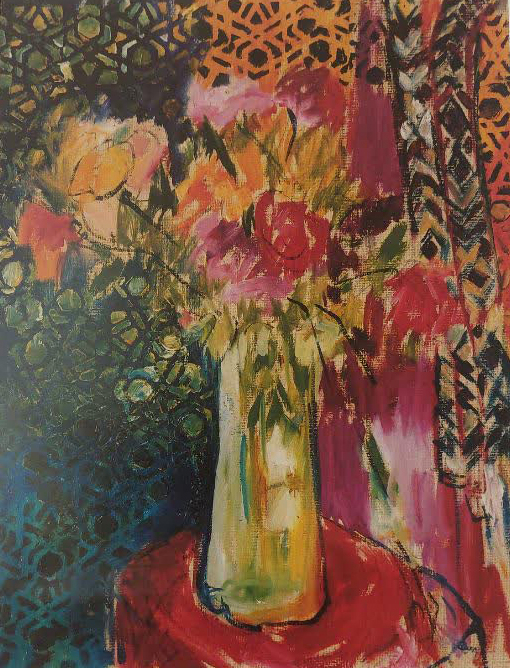 Oil Paint on Canvas, 1993, Pariyoush Ganji, https://www.artymag.ir/
Oil Paint on Canvas, 1993, Pariyoush Ganji, https://www.artymag.ir/
Pariyoush Ganji is a renowned Iranian artist known for her abstract expressionist paintings, which include portraits, landscapes, still life studies, trees, flowers, women, and faceless people. She has exhibited her work in Europe, Japan, and Iran, and has created several collections during the span of years 1997 to 2012, namely ‘Day, Night Windows’, ‘Roses’, ‘Windows Red’, ‘Sumi-e, Ink Paintings’, and ‘Windows, Memories of Childhood’. The exhibition ‘Windows’ at Tehran’s Aryana Gallery showcased her paintings from several series created over ten years, inspired by complex social issues. Often in her works, she focused onto white colour as ‘glimmers of hope’ in people’s lives.
Ganji’s contemporary works have been shown in private collections and international museums in England, Germany, Japan, Kazakhstan, Kyrgyzstan, Kuwait, Saudi Arabia, the United States, and Uzbekistan. In addition, she has curated 20 solo shows in Iran, England, Germany, Japan, Saudi Arabia, and Switzerland. Her shows have taken place in a variety of venues, including the Luci Mackintosh Gallery in Switzerland, the Bank Art Museum in Japan, and the Museum of Art and Science in the United States. In 2014, the Japanese government bestowed the award of “Shining Sun, Golden Lights with Neck Ribbon” to Pariyoush Ganji, known as “Kyokujitsu Chujyusho” in Japanese.
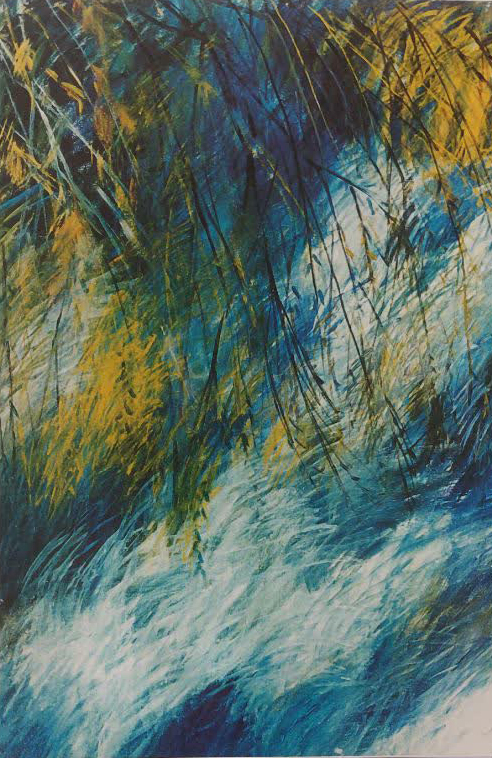 Oil Paint on Canvas, 2001, Pariyoush Ganji, https://www.artymag.ir/
Oil Paint on Canvas, 2001, Pariyoush Ganji, https://www.artymag.ir/
The Amalgamation of Tradition and Modern Concepts through Bita Ghezelayagh’s Feltwork.
Bita Ghezelayagh was born in Florence, Italy, in 1966. She presently lives in London. She has an MA in Architecture from the Ecole Nationale Architecture de Paris La Villette. She worked for the Association of Iranian Calligraphers in Tehran and was the art director of three notable Iranian films, including The Pear Tree by Dariush Mehrjui.
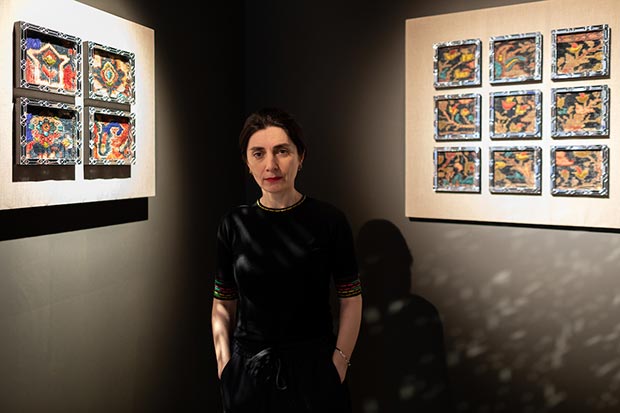 Iranian textile artist Bita Ghezelayagh, Courtesy of Aga Khan Centre Gallery, http://islamicartsmagazine.com/
Iranian textile artist Bita Ghezelayagh, Courtesy of Aga Khan Centre Gallery, http://islamicartsmagazine.com/
Persian artist Bita Ghezelayagh learned felt-making in Iran in 2003 and has had multiple solo shows in the UK and abroad. In Tehran, she also had exhibitions at The Collins Gallery, Albahreh Gallery, and Golestan Gallery. Her work has been displayed in group exhibitions across the world, notably at the Lajevardi Foundation, Shirin Gallery, and Aaran Projects Gallery in Tehran. She has taken part in significant art festivals and exhibits at a variety of venues, including the Sharjah Museum of Contemporary Art, Herbert Art Gallery, and the Jameel Prize at the Victoria and Albert Museum. Her art is in public and private collections worldwide, including the British Museum, the Farjam Foundation, the Devi Art Foundation, and the Victoria & Albert Museum’s Islamic Middle East Collection.
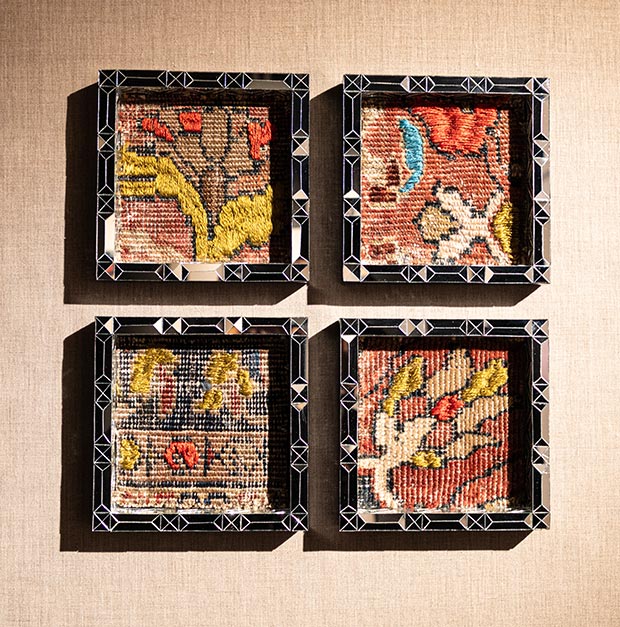 Bita Ghezelayagh, installation view from the exhibition / Courtesy of, Aga Khan Centre Gallery, http://islamicartsmagazine.com/
Bita Ghezelayagh, installation view from the exhibition / Courtesy of, Aga Khan Centre Gallery, http://islamicartsmagazine.com/
Ghezelayagh blends the skill of artisan and conceptual artist, and puts a modern touch to traditional fabrics, adding themes of love, royalty, communication, and conflict while glorifying the simplest elements of creative production. Her works incorporate cutters, weavers, embroiderers, and printers, elevating objects such as worn carpets to represent the age of casual discarding. Ghezelayagh’s triptych art piece incorporates abandoned materials like traditional cleaning gloves, while her diptych shows Cypress Trees made from remnants of carpets from Iran’s four corners. Her art is primarily concerned with the human body, with tactile elements such as shepherds’ cloaks, carpet tunics, and metal breastplates. Pen nib designs depict the enigma of human communication, and mirror forms are employed to create compositions evocative of Islamic geometric patterns prevalent across Iran. Ghezelayagh’s passion for historical textile materials and modern artefacts motivates her to rethread, retrace, refresh, and recreate her archive collection. Her work elevates the mundane into the spectacular, providing a new feeling of purpose through altering a material identity.
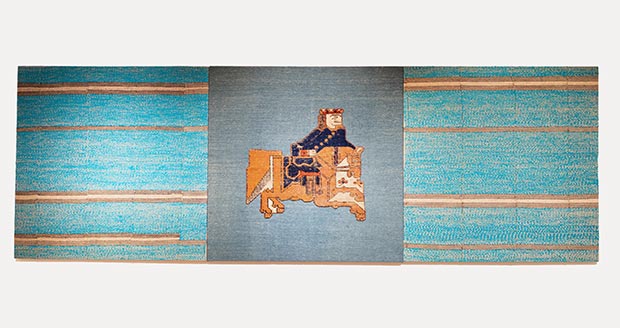 Bita Ghezelayagh, installation view from the exhibition / Courtesy of Aga Khan Centre Gallery, http://islamicartsmagazine.com/
Bita Ghezelayagh, installation view from the exhibition / Courtesy of Aga Khan Centre Gallery, http://islamicartsmagazine.com/
The Glimpses of the 1979 Revolution Captured in Expressive Photographs by Hengameh Golestan
Hengameh Golestan, who was born in Tehran in 1952, is a pioneer among Iranian female photographers. She began her photographic profession at the age of 18 and worked alongside her husband, Kaveh Golestan, to hone her talents. She was a member of a small group of documentary photographers that captured public protests in Tehran, with a concentration on women during and after the 1979 Iranian Revolution. Despite being unable to travel to the front lines of the Iran-Iraq War in the 1980s, she focused on concentrating on documenting village life in Kurdistan and other rural areas.
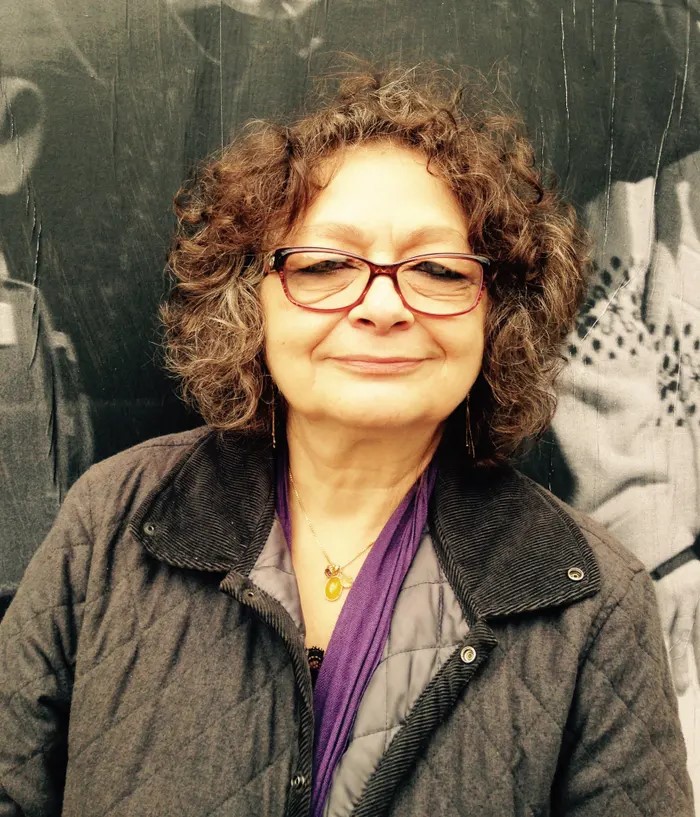 Hengameh Gulestan, https://www.theguardian.com/
Hengameh Gulestan, https://www.theguardian.com/
During the 1979 revolution, Golestan documented instances of female rebellion. She captured the last day for Iranian women to be unrestricted from the hijab when over 100,000 women marched across Tehran to oppose the new Islamic government’s hijab law. Gulestan, as a photographer, understood she had to capture this historic moment. She produced roughly 20 rolls of film in her darkroom, feeling proud of all the women and keen to show the best of them.
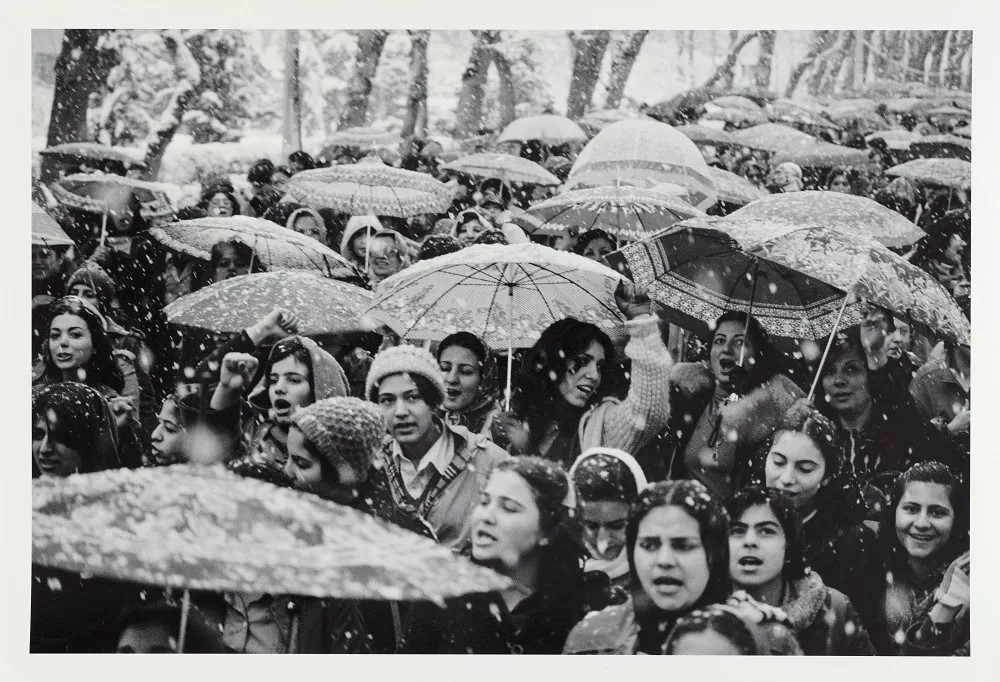 Untitled, from the series Witness 1979, Hengameh Golestan, March 11, 1979, Ink-jet Print, https://asia-archive.si.edu/
Untitled, from the series Witness 1979, Hengameh Golestan, March 11, 1979, Ink-jet Print, https://asia-archive.si.edu/
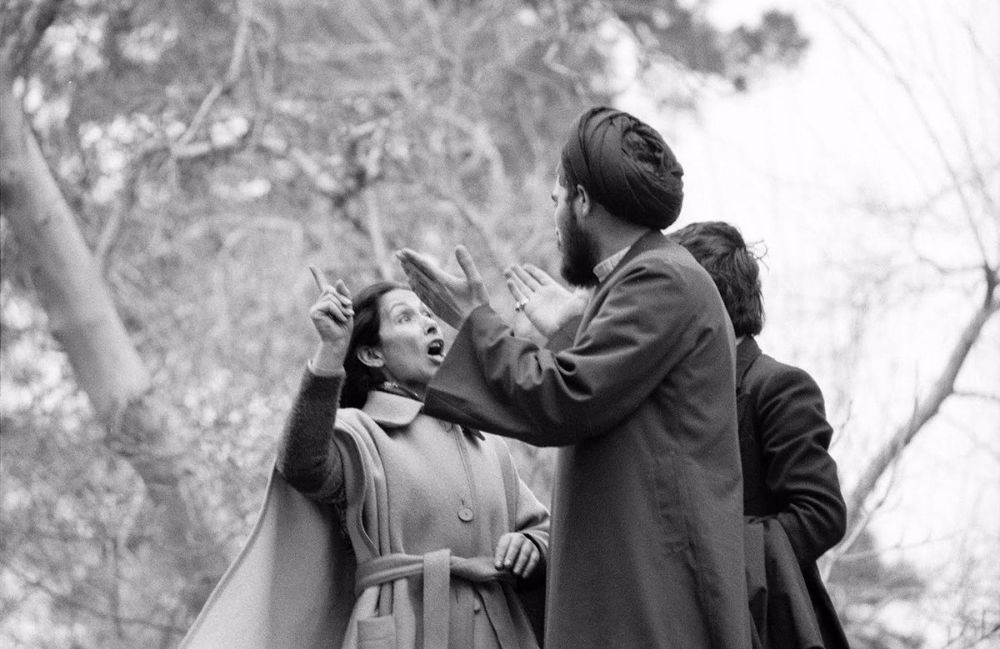 from the series Witness 1979, Hengameh Golestan, https://www.vintag.es/
from the series Witness 1979, Hengameh Golestan, https://www.vintag.es/
Shirin Neshat Explores the Existence of Women Within Male-Dominant Islamic Societies
Shirin Neshat, a well-known Persian artist in the Western world today, has earned a high level of respect and recognition for her work in photography, performance, cinema, and video. Her work focuses on Muslim women in both broad and intimate ways, challenging their status in Iranian society and how they are treated considering the cultural, religious, and political forces that shape their identities.
Shirin Neshat, born in 1957 in Qazvin, Iran, immigrated to the United States when she was 17 years old to continue pursuing her education. She received her BA, MA, and MFA from UC Berkeley before moving to New York City in 1983. Neshat worked at Manhattan’s Storefront for Art and Architecture. She returned to Iran in the early 1990s to observe the profound changes brought about by the 1979 Revolution. She felt imprisoned between American and Iranian traditions, and she struggled with longing for her pre-revolutionary Iran.
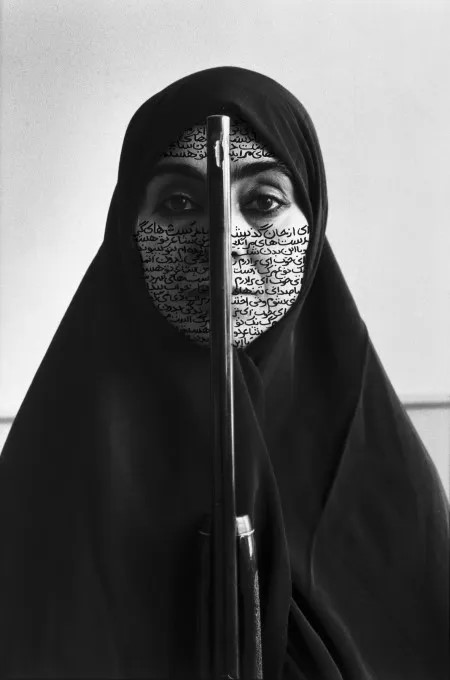 Rebellious Silence (1994), B&W RC print & ink, photo by Cynthia Preston, Copyright Shirin Neshat, Courtesy Gladstone Gallery, New York, and Brussels. http://signsjournal.org/
Rebellious Silence (1994), B&W RC print & ink, photo by Cynthia Preston, Copyright Shirin Neshat, Courtesy Gladstone Gallery, New York, and Brussels. http://signsjournal.org/
When she returned to the United States, she began researching issues in her native country, notably the situation of women in the primarily male-dominated Islamic culture. Her art, which included photography, Persian poetry, and calligraphy, gained international attention.
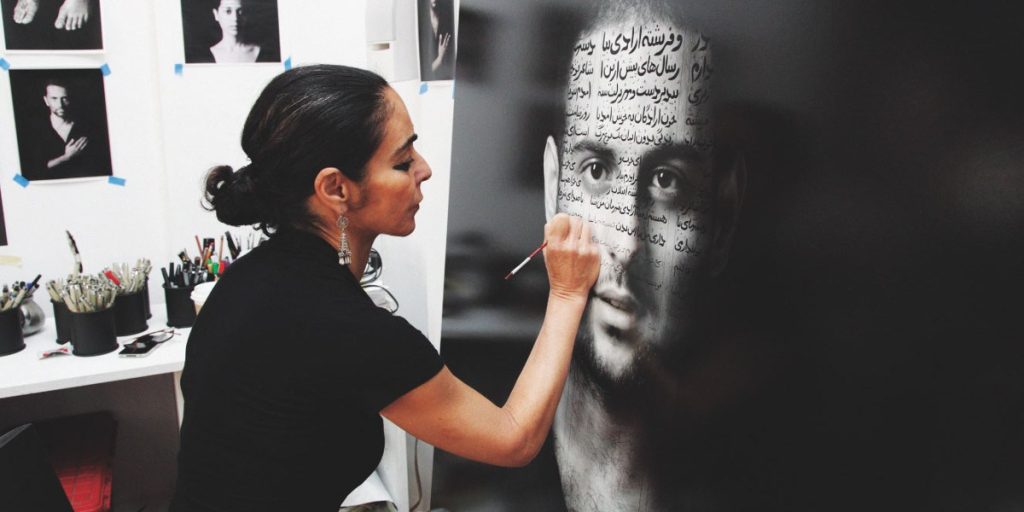 Shirin Neshat, https://www.widewalls.ch/
Shirin Neshat, https://www.widewalls.ch/
Unveiling (1993) by Shirin Neshat was a multimedia exhibition that examined the politics of women living behind the veil in Islamic nations. The show included images, sculptures, and films depicting women’s experiences with veiling. Neshat incorporated a bold representation of feminine sensuality and freedom by Iranian poet Furugh Farrukzad. She questioned the veil’s intricacies and conventional standards for modern women, concentrating on the female experience moulding the veil or the body. Neshat also discussed the difficulties of transferring Western feminist identity politics to Islamic societies. ‘Woman of Allah’, her first series of photographs, was created between 1993 and 1997 and blended images of women with religious inscriptions and proved to be one of her most celebrated series works.
Her work investigates Iranian femininity and Islamic fundamentalism. Neshat’s work has been shown at several galleries and institutions, including the Franklin Furnace, the Serpentine Galleries, and the Hirschhorn Museum and Sculpture Garden. Her work has won the “Golden Lion Award,” the “First International Prize at the 48th Venice Biennial”, the “Grand Prix of the Gwangju Biennial”, the “Hiroshima Freedom Prize”, and the “Dorothy and Lillian Gish Prize”. Neshat is represented by Gladstone Gallery in New York and Brussels. Her art frequently explores the issue of female estrangement in constrained Muslim countries.
Nazgol Ansarinia’s Explorations in Methods and Materials to Reveal the Inner Workings of a Social System
Nazgol Ansarinia, born in 1979 in Teheran, Iran, is a prominent artist who examines everyday objects and incidents to determine their connection with contemporary Iranian culture. Nazgol Ansarinia graduated from the London College of Communication in 2001 before enrolling in a Master of Fine Arts programme at the California College of the Arts (CCA) in San Francisco in 2003.
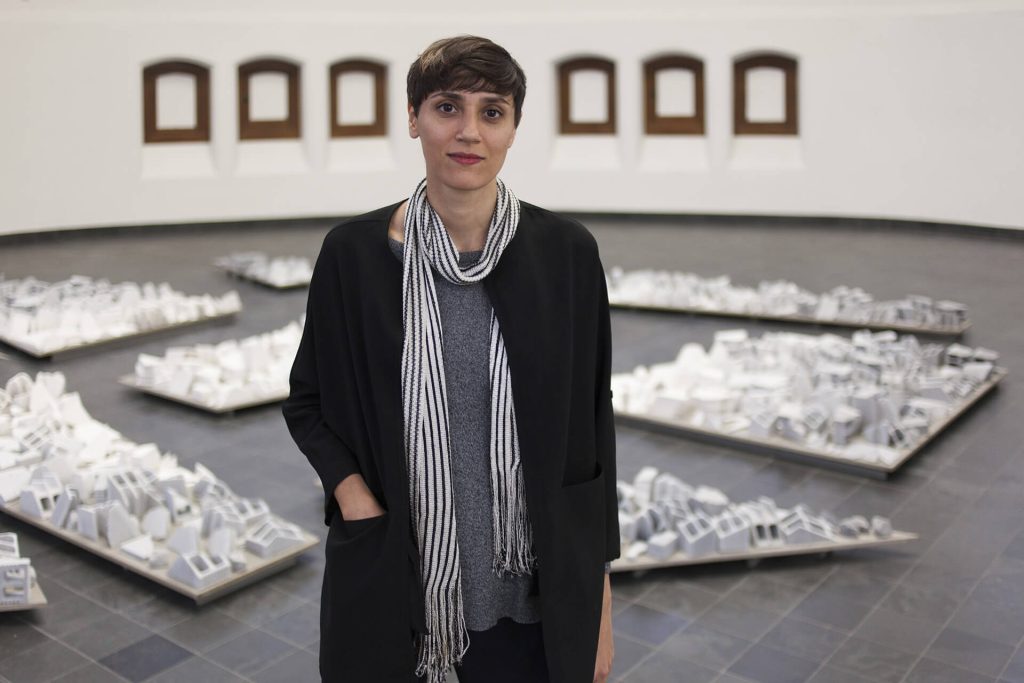 Artist Nazgol Ansarinia, https://www.stirworld.com/
Artist Nazgol Ansarinia, https://www.stirworld.com/
Ansarinia, an artist with interdisciplinary training in art and design, analyses the aesthetic and theoretical consequences of vernacular architectural practices within the built environment. Her works are mostly observational and technical, providing insights into the challenges faced by cities and their inhabitants. Her goal is to uncover the inner workings of a social system by dismantling and reassembling its components to reveal collective assumptions and underlying norms. Ansarinia’s work emphasizes research, and critical analysis is mainly influenced by her graphic design schooling. Her works are situated between the private realm and its wider socio-economic context, focusing on the built environment and physicality. Her works still contain traces of lived experiences, expressing the hopes and fears of people living in an increasingly globalized world.
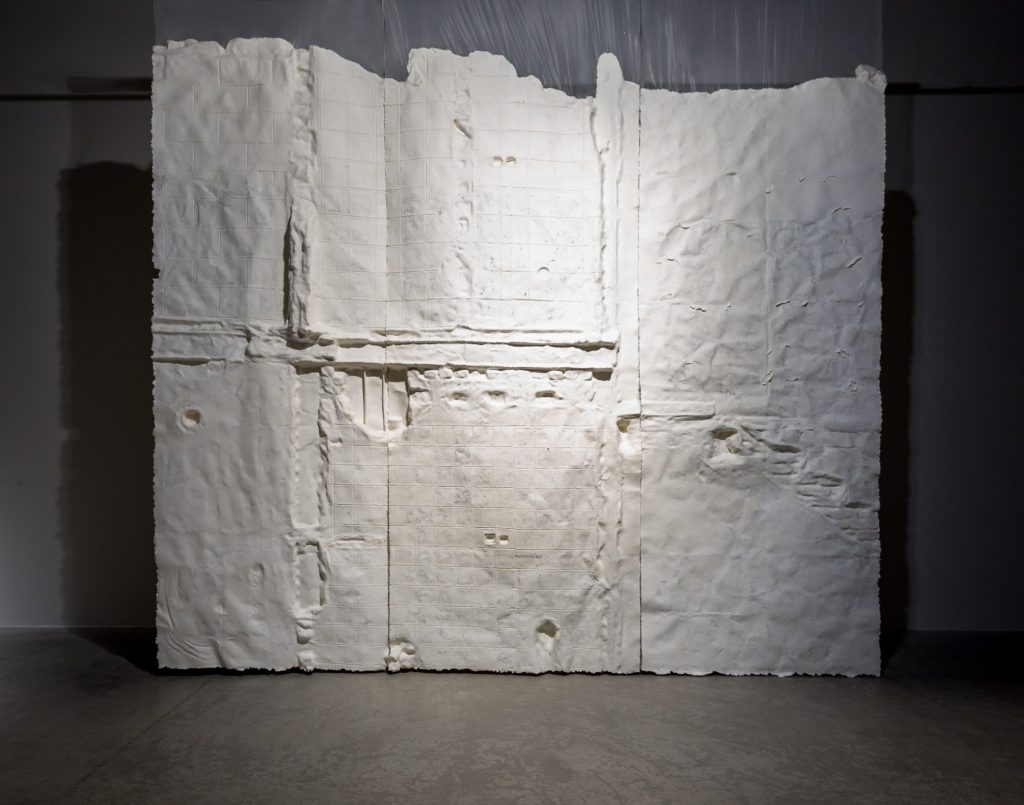 Surfaces + Solids, Nazgol Ansarinia
Surfaces + Solids, Nazgol Ansarinia
Installation view at Green Art Gallery, Dubai, 2015, https://www.gagallery.com/
Nazgol Ansarinia received the “Abraaj Capital Art Prize” in 2008 and represented Iran in the “National Pavilion at the 56th Venice Biennale”. Her work has been shown as a part of solo exhibitions in galleries such as Kunst Museum Liechtenstein, Vaduz (2022); Pools and Voids, Galleria Raffaella Cortese, Milan (2021); Nazgol Ansarinia: The Room Becomes a Street, Pejman Foundation, Tehran (2020); Fragments, Particles and the Mechanisms of Growth, KIOSK, Ghent (2017); Paper trail, Galleria Raffaella Cortese, Milan (2016); Interior Renovations, Tehran, 2010, Green Cardamom, London (2011). Additionally, she has held several group exhibits with galleries in Iran and abroad.
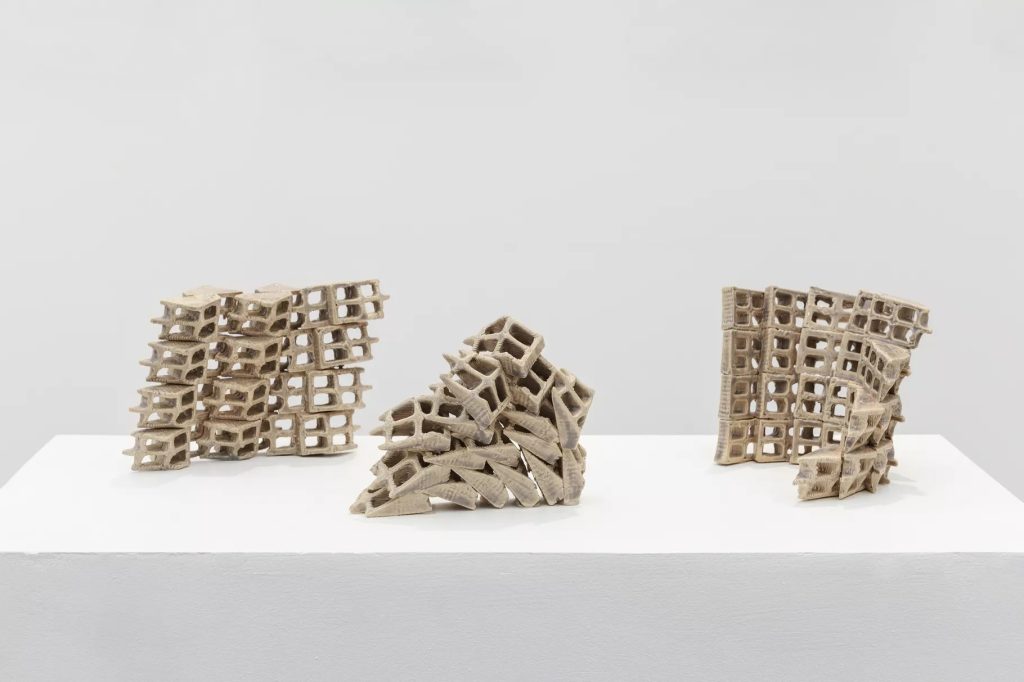 Nazgol Ansarinia, Attempts at building a wall, 2018, Green Art Gallery, https://www.artsy.ne
Nazgol Ansarinia, Attempts at building a wall, 2018, Green Art Gallery, https://www.artsy.ne
Conclusion
Once mostly concealed from Western eyes, Iran’s modern art sector is now thriving as an influential social and cultural movement. In the years following the Islamic Revolution and the Iran-Iraq conflict, contemporary and young Iranian artists are fusing the rich tradition of Persian art with radical new techniques of self-expression. Iranian women artists working in various domains of creative practice have significantly contributed to Iran’s art sector claiming its place in the international art market. The richness and beauty of Iranian culture, complex depictions of human dilemmas in Islamic societies, empowerment and equality, and abstract expressionism through symbolic and minimal representation are some of the recurring themes in the works of Iranian women artists, representing their works to be powerful, fearless, and intellectually sound, emerging a new view of Islamic culture.
References:
Online Articles:
- Alia Kawar, “Art & Resilience: Iranian Female Artists,” 11th Oct 2022, Emergeast
- “I can only depict the faces of those with whom I have some kind of inner dialogue,”28th October 2022, Visual Arts Magazine
- Susanna Schrobsdorff,20th September 2021, “The Quietly Rebellious Art of Iranian Women and What We Can Learn From Them”, It’s not Just You, Time
- “Rethreading and Retracing: Textiles & Techniques by Bita Ghezelayagh”, 20th March 2020, Inspo Exhibition, Islamic Art Magazine
- Sameer Rahim, 28th November 2018, “From Iran, with love—an artist preserves a dying tradition”, Culture, Prospect
- Sian Cain, 3rd September 2015, “Hengameh Golestan’s best photograph: Iranian women rebel against the 1979 hijab law”, The Guardian
- “Paintings in Praise of light and hope”, 19th June 2015, Art & Culture, Tribune
Websites:
- “Shirin Neshat Unveiling (1993)”, Hemispheric Institute
- “Shirin Neshat,” National Museum of Women in the Arts
- “Nazgol Ansarinia,” Galleria Rafaella Cortese
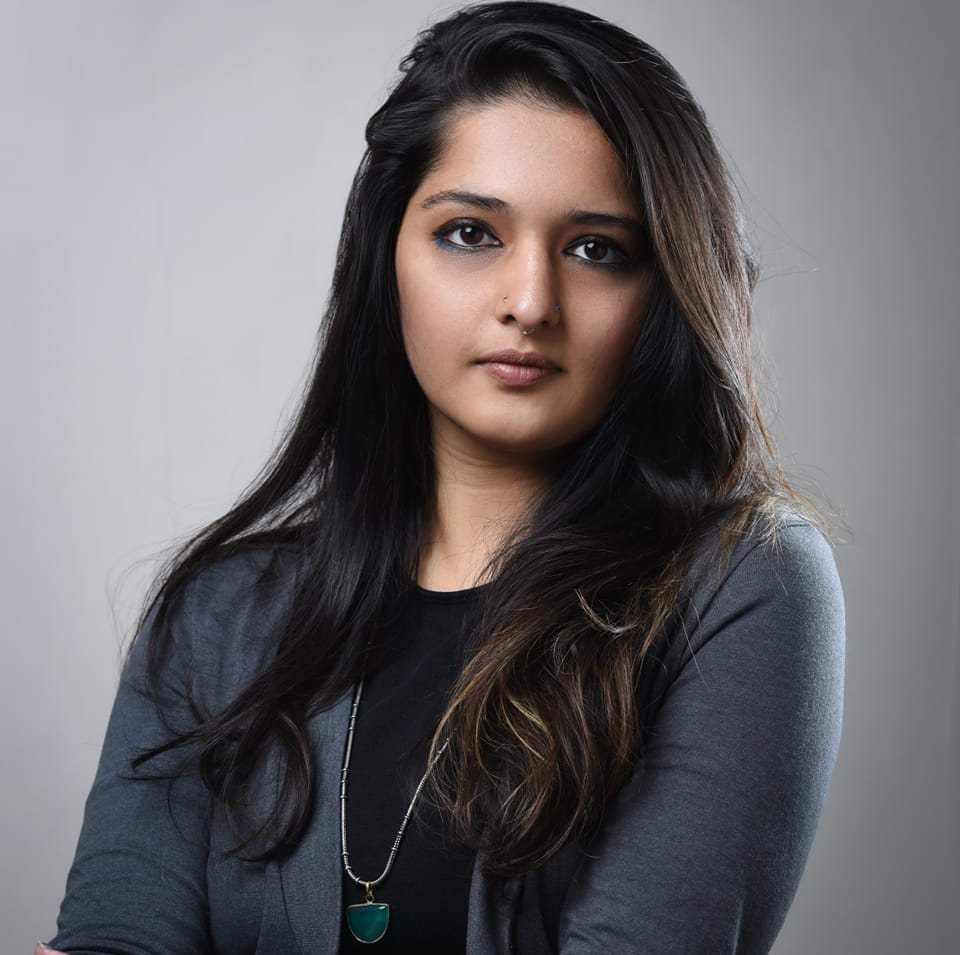
Contributor

